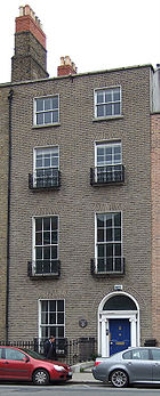
Baggot Street, Dublin
Encyclopedia
Baggot Street is a street in Dublin, Ireland
. It is named after Baggotrath, the manor granted to Robert Bagod in the 13th century. It was called Baggot Street in 1773.
It runs from Merrion Row (near St. Stephen's Green
) to the northwestern end of Pembroke Road. It crosses the Grand Canal
near Haddington Road. It is divided into two sections:
Lower Baggot Street is distinguished by Georgian architecture
, while Upper Baggot Street has mainly Victorian architecture
with a few buildings of 20th century vintage. Cook's Map of 1836 shows the north side of Upper Baggot-street and Pembroke Road almost entirely built on.
The Royal City of Dublin Hospital, Baggot Street
is on the east side of Upper Baggot Street, just south of the junction with Haddington Road. It was opened in 1834.
 The Sheares Brothers
The Sheares Brothers
, members of the Society of United Irishmen, who died in the 1798 rebellion, lived at no. 128.
In 1830, Thomas Davis, the revolutionary Irish writer who was the chief organizer and poet of the Young Ireland movement, lived at 67 Lower Baggot Street.
Catherine McAuley
, a nun, founded the Sisters of Mercy
order in 1831 and built the Mercy International Centre
on Lower Baggot Street where she later died in 1841.
In 1909, Francis Bacon
was born at 63 Lower Baggot Street.
Republic of Ireland
Ireland , described as the Republic of Ireland , is a sovereign state in Europe occupying approximately five-sixths of the island of the same name. Its capital is Dublin. Ireland, which had a population of 4.58 million in 2011, is a constitutional republic governed as a parliamentary democracy,...
. It is named after Baggotrath, the manor granted to Robert Bagod in the 13th century. It was called Baggot Street in 1773.
It runs from Merrion Row (near St. Stephen's Green
St. Stephen's Green
St Stephen's Green is a city centre public park in Dublin, Ireland. The park is adjacent to one of Dublin's main shopping streets, Grafton Street, and to a shopping centre named for it, while on its surrounding streets are the offices of a number of public bodies and the city terminus of one of...
) to the northwestern end of Pembroke Road. It crosses the Grand Canal
Grand Canal of Ireland
The Grand Canal is the southernmost of a pair of canals that connect Dublin, in the east of Ireland, with the River Shannon in the west,via Tullamore and a number of other villages and towns, the two canals nearly encircling Dublin's inner city. Its sister canal on the Northside of Dublin is the...
near Haddington Road. It is divided into two sections:
- Lower Baggot Street - between Merrion Row and the Grand Canal. It was called Gallows Road in the 18th century.
- Upper Baggot Street - south of the Grand Canal until the junction with Eastmoreland Place, where it continues as Pembroke Road.
Lower Baggot Street is distinguished by Georgian architecture
Georgian Dublin
Georgian Dublin is a phrase used in the History of Dublin that has two interwoven meanings,# to describe a historic period in the development of the city of Dublin, Ireland, from 1714 to the death in 1830 of King George IV...
, while Upper Baggot Street has mainly Victorian architecture
Victorian architecture
The term Victorian architecture refers collectively to several architectural styles employed predominantly during the middle and late 19th century. The period that it indicates may slightly overlap the actual reign, 20 June 1837 – 22 January 1901, of Queen Victoria. This represents the British and...
with a few buildings of 20th century vintage. Cook's Map of 1836 shows the north side of Upper Baggot-street and Pembroke Road almost entirely built on.
The Royal City of Dublin Hospital, Baggot Street
Royal City of Dublin Hospital, Baggot Street
The Royal City of Dublin Hospital on Upper Baggot Street, Dublin, Ireland, was built in 1832. Its facade is of red brick and terracotta tiles, set back from the street.-History:The hospital was built to the designs of the architect Albert E...
is on the east side of Upper Baggot Street, just south of the junction with Haddington Road. It was opened in 1834.
Notable residents

The Sheares Brothers
The Sheares Brothers, Henry , and John were Irish lawyers and members of the Society of United Irishmen, who died in the 1798 rebellion.-Early lives:...
, members of the Society of United Irishmen, who died in the 1798 rebellion, lived at no. 128.
In 1830, Thomas Davis, the revolutionary Irish writer who was the chief organizer and poet of the Young Ireland movement, lived at 67 Lower Baggot Street.
Catherine McAuley
Catherine McAuley
The Venerable Mother Catherine Elizabeth McAuley was an Irish nun, who founded the Sisters of Mercy in 1831...
, a nun, founded the Sisters of Mercy
Sisters of Mercy
The Religious Order of the Sisters of Mercy is an order of Catholic women founded by Catherine McAuley in Dublin, Ireland, in 1831. , the order has about 10,000 members worldwide, organized into a number of independent congregations....
order in 1831 and built the Mercy International Centre
Mercy International Centre
Mercy International Centre is the original house of the Sisters of Mercy. Built in 1824 by Catherine McAuley, it is located on Lower Baggot Street, Dublin, Ireland....
on Lower Baggot Street where she later died in 1841.
In 1909, Francis Bacon
Francis Bacon (painter)
Francis Bacon , was an Irish-born British figurative painter known for his bold, austere, graphic and emotionally raw imagery. Bacon's painterly but abstract figures typically appear isolated in glass or steel geometrical cages set against flat, nondescript backgrounds...
was born at 63 Lower Baggot Street.

